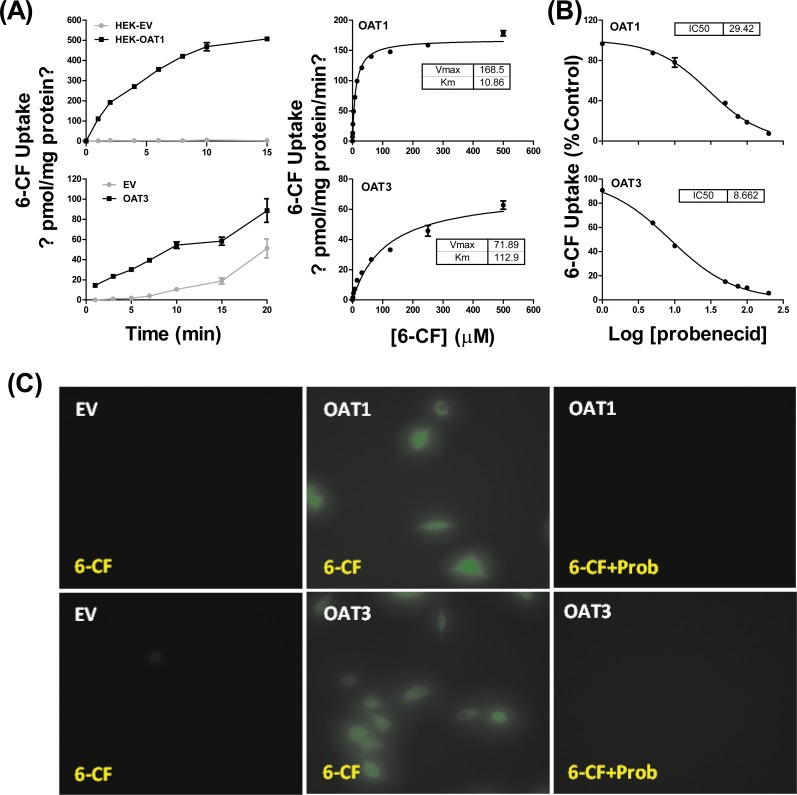Human Transporter 0AT3 Fluorescence-based Antagonist Assay Service
Driving Immunotherapy Forward with Innovative Transporter Assays
Creative Biolabs is delighted to introduce our human organic anion transporter 3 (OAT3) fluorescence-based antagonist assay service. This specialized service is designed to support the development of immunotherapy by providing comprehensive In Vitro ADME services. Our ADME services provide thorough analysis and optimization of drug candidates, ensuring their suitability for immunotherapy applications. Our goal is to facilitate and enhance the advancement of effective immunotherapeutic solutions.
Our ADME services include but are not limited to:
OAT3 is an important membrane transporter involved in the renal clearance of a variety of endogenous substances and drugs. Understanding the role and interactions of OAT3 is critical for the development of targeted immunotherapies, as drug release and potential drug-drug interactions play an important role. Our fluorescence-based antagonist assay provides accurate and reliable information on OAT3 activity to help identify and characterize potential therapeutic agents. We use CHO-K1 cells and fluorometry to measure the effects of its counteracts 6-CF substrate fluorescence in activity assays.
Assay Information:
|
Substrate
|
Assay Type
|
Cell Type
|
Functional Mode
|
Detection Method
|
Measured Response
|
|
6-CF
|
Functional
|
CHO-K1
|
Antagonist
|
Fluorimetry
|
Fluorescence
|
Workflow
|
1. Cell Culture Preparation
|
-
CHO-K1 cells are cultured in growth media optimized for maintaining cell viability and functionality.
|
|
2. Assay Plate Preparation
|
-
96-well assay plates are treated with poly-D-lysine to promote cell adherence and consistency across all wells.
|
|
3. Cell Seeding and Incubation
|
-
Detached CHO-K1 cells are counted and seeded into the assay plates at a predetermined density per well.
|
|
4. Assay Setup
|
-
Test compounds, including potential antagonists, are prepared in various concentrations using the assay buffer.
-
Each well receives assay buffer containing 6-CF substrate, followed by the addition of test compounds.
|
|
5. Incubation and Reaction Initiation:
|
-
The assay plates are incubated to facilitate interaction between the test compounds and CHO-K1 cells.
|
|
6. Fluorescence Measurement
|
-
Excitation and emission wavelengths optimized for the 6-CF substrate are employed to ensure accurate measurement of fluorescence response.
|
|
7. Data Analysis
|
-
Concentration-response curves are constructed and IC50 values may be calculated to assess antagonist potency.
|
Published Data
This study provides a comprehensive review of the interactions between plant compounds and human organic ion transporters (OAT1 and OAT3). Characterization of OAT1- and OAT3-expressing HEK293 cells in the study clarifies how these transporters mediate the uptake and secretion of various cellular components, and access herbs and drugs communication effects. This trend contributes to the understanding of how plant compounds can affect pharmacology and pharmacokinetics by altering transporter activity.
 Fig.1 6-CF uptake in OAT1- and OAT3-expressing HEK293 cells.1
Fig.1 6-CF uptake in OAT1- and OAT3-expressing HEK293 cells.1
Applications
-
Assessing the efficiency of antagonist compounds concentrated on 0AT3 transporter interest.
-
Investigating the position of 0AT3 in cell delivery mechanisms.
-
Screening capacity drug applicants for modulating 0AT3 characteristics.
Advantages
-
Utilizing 6-CF substrate and fluorimetry, our assays ensure precise measurement of fluorescence response.
-
Suitable for various test compounds and concentrations to assess antagonist results.
-
Interpretation of consequences and strategic guidelines provided through our experienced group.
Creative Biolabs gives strong skills for assessing antagonist outcomes at the 0AT3 through the use of fluorescence-based assays, supporting advancements in transporter biology and drug discovery. For extra statistics regarding our assay offerings or to talk about task-precise requirements, please contact us for customized help.
Reference
-
Lu, Hang, et al. "Interactions of 172 plant extracts with human organic anion transporter 1 (SLC22A6) and 3 (SLC22A8): a study on herb-drug interactions." PeerJ 5 (2017): e3333.
For Research Use Only | Not For Clinical Use


 Fig.1 6-CF uptake in OAT1- and OAT3-expressing HEK293 cells.1
Fig.1 6-CF uptake in OAT1- and OAT3-expressing HEK293 cells.1
 Download our brochure
Download our brochure